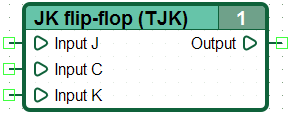| This documentation is out of date.
The new version of the documentation is here: https://cannylogic.com/docs |
JK flip-flop
From CANNY Wiki
| Appearance | |
|---|---|

| |
| Symbol | |
| TJK | |
| Group | |
| Flip-flops / Latches | |
| Inputs | |
| Input J: | Integer |
| Input C: | Logical |
| Input K: | Logical |
| Outputs | |
| Outputs: | Integer |
| Version CANNY Lab | |
| from 0.11b | |
Simultaneous two-stage JK flip-flop, changes its internal state on the rising edge at the input "C", depending on the status of the inputs «J» and «K», then at the falling edge on the input «C» copies its internal state to the output.
Variants of the flip-flop, depending on its inputs states:
- If the input «J» = 0 and «K» = 0 - the internal state will not change;
- If the input «J» = 0 and «K» > 0 - the internal state becomes zero
- If the input «J» > 0 and «K» = 0 - the internal state becomes equal to the value of «J»
- If the input «J» > 0 and «K»> 0, then:
- if the current internal state is zero, it will become equal to the value of «J» input
- if the current output value is not zero, then it becomes zero
In the time interval between edges on the input «C» the internal state and the state of the flip-flop output remain unchanged regardless of the inputs «J» or «K» values.
Features
The chain of JK-flip-flops can be used for efficient queuing (FIFO buffers).
Examples
Example 1:
Example 2:
Example 3:







